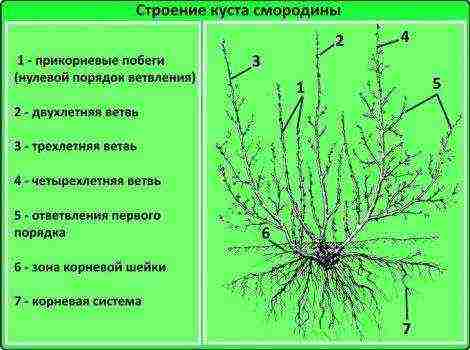Content [show]
It's no secret that tomatoes are one of the most beloved vegetable crops, which are happily grown in their summer cottages. Therefore, such a responsible event as planting tomato seedlings in open ground should not be allowed to go on its own. Explanatory advice and recommendations from experienced gardeners will help determine the correct timing of planting seedlings, as well as how best to prepare and properly care for them.

Dates of planting tomato seedlings in open ground
Depending on the climatic characteristics of your region of residence and the current weather conditions, the timing of planting tomato seedlings in open ground may vary. But, as a rule, in the Middle Lane (Moscow region) it falls on the second half of May - early June, in the Urals and Siberia not earlier than the end of May - mid-June, and in the southern regions much earlier - in late April - early May.
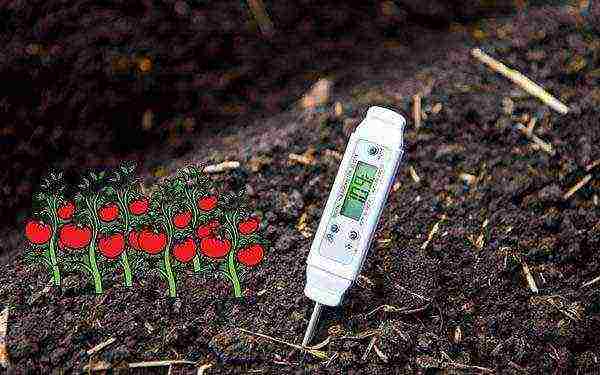
Advice! The main guideline for planting tomatoes and other vegetables is soil temperature, which by this time should warm up to at least + 10-12 degrees, and even better up to + 13-15 degrees. Moreover, the depth of warming up should be practically the bayonet of a shovel (20 centimeters), in other words, this is the depth of the landing hole. At about this depth, you should place a thermometer in the ground to find out its temperature.
If you are going to plant tomato seedlings under a covering film or other material, you can do it a little earlier, about a week. Tomatoes are planted in the greenhouse even earlier.
Important!You need to be sure that return spring frosts will not return, because if the soil temperature drops to 0 - + 2 degrees, then the plants are likely to simply freeze and die.
Depending on the variety of tomatoes you choose according to the degree of ripening, the seedling period can last:
- for early adopters - 40-50 days;
- for medium - 50-70 days;
- for late - 70-80 days.
Lunar calendar

The lunar calendar of 2018 shows us the following favorable days for planting tomato seedlings in open ground:
- in April - 5-9; 20-24;
- in May - 4-9, from 19-23.
Unfavorable days according to the lunar calendar 2018, on which you should not plant are:
- in April - 15-17, 29-30;
- in May - 14-16, from 28-30.
- June - 12-14, 28.
Preparing tomato seedlings for planting
The first thing to do with tomato seedlings as preparation before planting in open ground is her temper... It is optimal to do this 2 weeks before the expected date of transplanting to the garden. For example, you can take it out to a balcony or a heated greenhouse, where the temperature does not drop below +10 degrees. On the first day, seedlings will be enough half an hour stay in new more severe conditions.Next, increase the time proportionally and gradually bring it up to a full day.
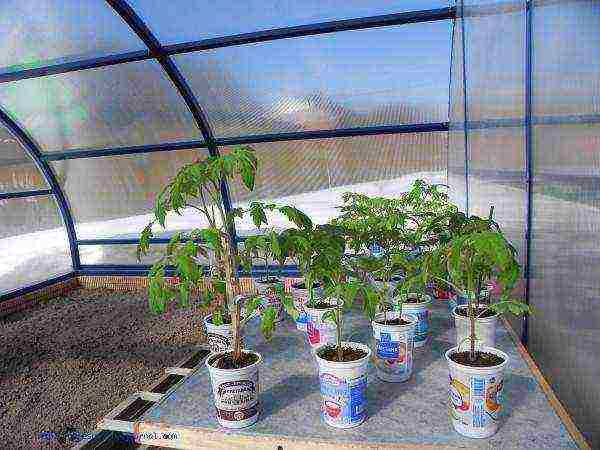
Important! The seedlings should not be allowed to get sunburn from the too bright spring sun, so try to put the planting containers with seedlings in partial shade or somehow shade it.
7 days before planting in the ground, tomato seedlings should be fed, it is optimal to have time to do this in the morning or evening hours. Experienced gardeners advise using exactly foliar feeding by spraying the drug over the foliage with a spray bottle. This is because foliage is already able to absorb nutrients and trace elements. For example, for better survival, you can spray tomato seedlings with a growth stimulant solution. epin extra (based on 1 ml per 5 liters of water).
Root dressing also allowed. For example, you can feed a fertilizer such as gumistar (liquid vermicompost). The fertilizer must be diluted with water in a ratio of 1 to 50, for example, 10 ml of the product in 0.5 liters of water. Gumistar, in principle, is also suitable for spraying the leaf surface of tomato seedlings (foliar feeding), but in this case, the amount of the drug should be reduced by 4 times, in other words, 1 to 200 or 5 ml of the product per 1 liter of water.
Advice! If you are growing seedlings tall tomatoes or is she just very stretched out a lot, but the lower leaves turned yellow, then in 3-5 days it is necessary remove all lower leaves (including cotyledons), and then also feed.
Finished appearance for landing in open ground tomato seedlings should be as follows: 25-35 centimeters in height (measured from the root collar), 6 to 10 true dark green leaves, the first bud ovaries.
Advice! If possible (if you have a lot of seedlings), it is worth discarding all non-standard seedlings that stand out from the general mass. For example, they are too small or too tall. Most likely, something is wrong with them.

It is also possible in advance (one day before disembarkation)process seedlings tomato from pests. It is optimal to do this long before the appearance of fruits, so that by the time of harvesting, the entire preparation has long been removed from the plant. According to experienced vegetable growers, the drug "Antichrushch" shows itself well, which protects against beetles, wireworms, bears, whitefly in a greenhouse.
The procedure for processing seedlings with an open root system (if your seedlings grow in a common container) is as follows: just immerse the plant roots in the solution for 1 hour. You need to prepare the solution as follows: take 10 ml of the drug and dissolve in 1 liter of water.

With a closed root system: water each glass or pot of seedlings with 30-50 ml of solution. The solution is prepared in a lower concentration: 10 ml of the drug per 10 liters of water.
Video: preparing tomato seedlings for planting in open ground
Preparing the soil and beds for tomatoes
It is advisable to prepare a garden bed for growing tomatoes in the fall, adding humus and wood ash to it, and then digging it well. Optionally, you can add bio-peat, deoxidized high-moor peat and river sand.
To improve the structure and nutritional value of the soil, you can plant winter crops in the future garden bed, for example, oats or vetch, before winter. Actually, if you plant green manure in spring, the effect will be similar.
Advice! It will not be superfluous to check the acidity of the soil; for the successful cultivation of tomatoes, the acidity should be neutral, about 6-7 pH. If the acidity is below 5.5, then you should use one of the deoxidizers, for example, dolomite flour,.

If you are making and preparing the garden in the spring, then you should carefully approach the fertilization before planting. So, right into the hole before planting seedlings, you should pour a little wood ash (about 1 tbsp. Spoon), or a handful of humus and 1 tbsp. a spoonful of superphosphate, or a handful of vermicompost, and then mix thoroughly with the soil.
Advice! To disinfect the soil, add 1-2 tablets of "Trichocin" or "Glyocladin" for 1 plant.
As for crop rotation, the best predecessors for planting and growing tomatoes will be onions, carrots, beets, cabbage, and any legumes. The worst, after which it is undesirable to plant - all nightshades, eggplants, peppers, potatoes and the tomato itself. Moreover, it cannot be planted within 3-4 years.
Thus, if you want to get a good harvest of tomatoes, then every year you need to either find a new place for planting tomato seedlings, or carefully remove the entire top layer of soil and fill it with new fertile soil.
By the way! After tomatoes, it is recommended to plant only those vegetables that enrich the soil with nitrogen: legumes (peas, beans); pumpkin (pumpkin, zucchini, cucumbers); root vegetables (carrots, beets); cabbage (white and red cabbage, Brussels sprouts, cauliflower, kohlrabi), onions and garlic.
Video: preparing the soil for planting tomatoes in open ground
Planting tomato seedlings in open ground on a garden bed
As for the time, it is best to choose either cloudy weather for planting tomato seedlings, or the afternoon in the late afternoon when the sun sets.
The optimal size of a bed for planting tomatoes: if you want to make a high bed, then its height should be about 15-25 centimeters, and a width of 0.9-1.2 meters.

The optimal scheme for planting tomato seedlings: holes are made in a checkerboard pattern at a distance of 30-40 cm from each other in a row and 50-70 cm in aisles. If you have tall tomatoes, then the distance between the seedlings should be increased by 20 centimeters.

Advice! In order for the roots of seedlings to remain completely intact, the earthen lump should be watered about an hour and a half before planting the seedlings on the garden bed. If you cannot reach the plant, then a cardboard or plastic cup can be easily cut with scissors. And if your seedlings grew in peat tablets, then you do not need to take them out.
Step-by-step instructions for planting tomato seedlings on a garden bed in open ground:
- Prepare the garden bed in the fall, or do it in the spring.
- Determine when it will be possible to plant.
- Prepare seedlings: harden, feed and treat pests.
- Prepare the garden bed and install shelter arches.
- Dig holes and add fertilizer to them.
- Spill water, approximately 3-4 liters per well.
- Plant tomato seedlings, deepening the seedlings to the cotyledonous leaves or even deeper (in this case, the lower leaves must be cut off). Elongated or overgrown, as well as tall tomatoes, it is advisable to plant at an angle, cutting off all the lower leaves.
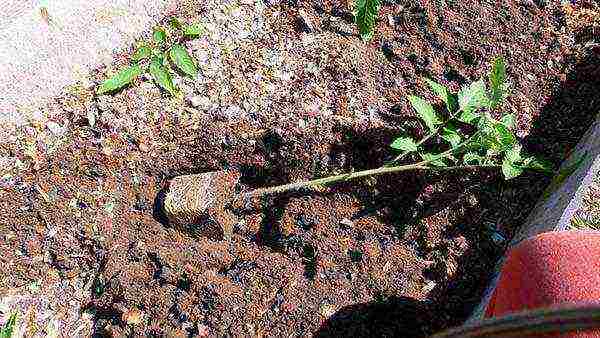
- Then you need to compact the soil next to the seedling and sprinkle with loose earth. Overgrown and tall tomatoes must also be tied to the pegs.

- Low-growing tomatoes can be carefully mulched with hay or straw, for example. Tall varieties do not need to be mulched yet. This will need to be done when the seedlings take root, as well as after another removal of the lower leaves. Moreover, forest litter should be used as mulch.
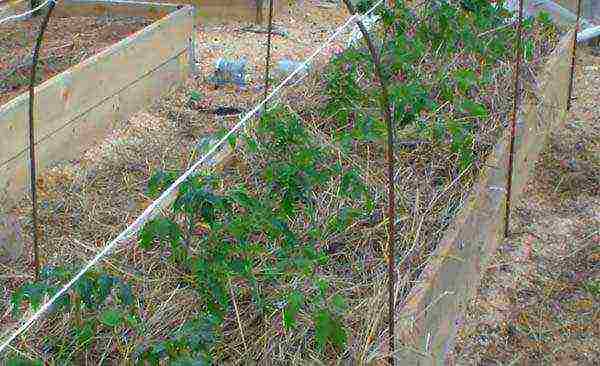
- Cover the beds with foil or any other covering material.
Video: how to plant tomatoes in open ground
Note! You can find out about when and how to plant tomatoes in a greenhouse from this article.
Outdoor tomato care
What must necessarily be included in the basic steps for caring for tomatoes in the open field is:
- watering;
- mulching (optional, but desirable);
- loosening and weeding (depending on the presence / absence of mulch):
- top dressing;
- formation, pinching and pruning (and depending on the varietal affiliation);
- a garter (like the previous point, although even undersized tomatoes are tied up by many, so at will);
- protection from pests and diseases.
Watering
After you plant the tomatoes in the garden, the first 1-2 weeks you can not water them and give time to settle down in a new place. Next, they will need a regular weekly watering... The optimal water consumption for 1 bush is 3-4 liters. In the summer heat and drought, the amount of watering, of course, will need to be increased. Moreover, it is most effective to water in the evening, so the moisture will evaporate less.
When the tomatoes themselves begin to set and actively grow, during this period it is worthwhile to pay special attention to maintaining the soil near the tomatoes in a moist state. For this purpose, it will perfectly cope mulch, as which you can use: straw and hay (as mentioned earlier, ideal for low-growing varieties of tomatoes), compost, humus, peat, sawdust and wood chips.

Important! Tomatoes should be watered only exclusively at the root, in no case by sprinkling, because it can lead to plant disease.
Do not forget after each irrigation of tomato beds loosen land around the seedlings and weed from weeds.
Note! You can learn all the intricacies of watering tomatoes,after reading this article.
Video: how to properly water tomatoes
Top dressing
Tomatoes begin to feed already a few weeks after planting seedlings in the garden. As a rule, the following feeding scheme is used:
- First feeding carried out in 2-3 weeks. At this stage of development, seedlings require nitrogen. Nettle infusion is perfect (200 ml per 1 bush), or you can prepare the following solutions: 1 tbsp. Dissolve a spoonful of nitrophoska and 0.5 liter of mullein (or 1 tbsp. spoonful of Ideal fertilizer) in 1 bucket of water, the consumption rate is 500 ml per 1 plant. According to experienced gardeners, feeding with a solution of ammonia (2 tablespoons of 10% alcohol per 10 liters of water) in a proportion of 1 liter per 1 bush is even more effective.
Video: feeding tomatoes with ammonia
- The second feeding should be done already during the beginning of flowering and during the budding period. The plant at this moment needs potash fertilizers. For this, an ash solution (1 liter can of ash for 1 bucket of water) or potassium humate (Bio Humate) are suitable, in the calculation of 20 ml of the product for 10 liters of water.
Video: feeding tomatoes with ash
- Moment third feeding occurs during fruiting. You can use the same fertilizers as on second stage.
Important! Before feeding the tomatoes, they should be thoroughly spilled with water so that the fertilizer, God forbid, does not burn their root system.
To stimulate the appearance of ovaries, in other words, to accelerate the ripening of tomatoes, it is good to usefoliar dressing of tomatoes... For example, a boric acid solution is suitable for this (at the rate of 10 g of the product per 1 bucket of water, and preferably hot, but spraying should be carried out only when the solution is completely cooled) or special preparations such as Tomaton or Ovary. This spraying should be done during the 1st or 2nd feeding.
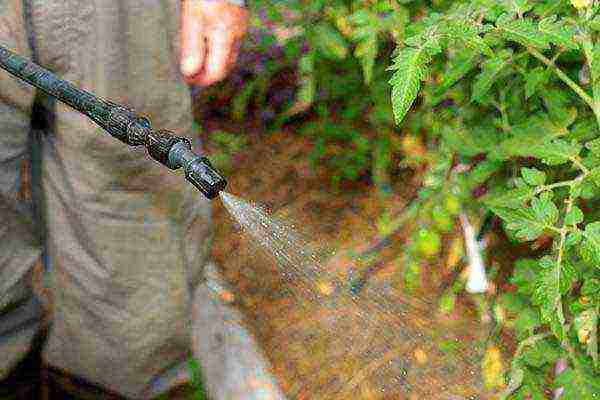
More detailed information on feeding tomatoes will be given in the following materials on the site.
Shaping: pinching and pruning
Over time, stepchildren begin to appear in medium and tall tomatoes. They are absolutely useless, but the plant spends energy on them, which is why it itself weakens and slows down in growth (including fruiting). Therefore, it is recommended to carry out weekly pinching of tomatoes. This does not require any scissors or pruning shears, it is very convenient to remove the stepsons with the index and thumb. Moreover, it is imperative to leave a small stump (about 1 centimeter), otherwise, if you completely remove it, then a new stepson will soon appear.
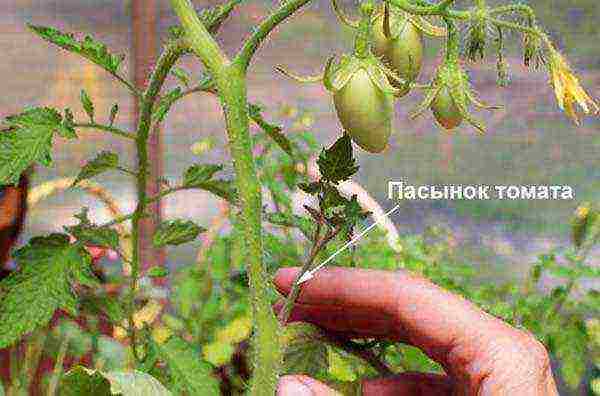
Try to remove stepchildren as early as possible.
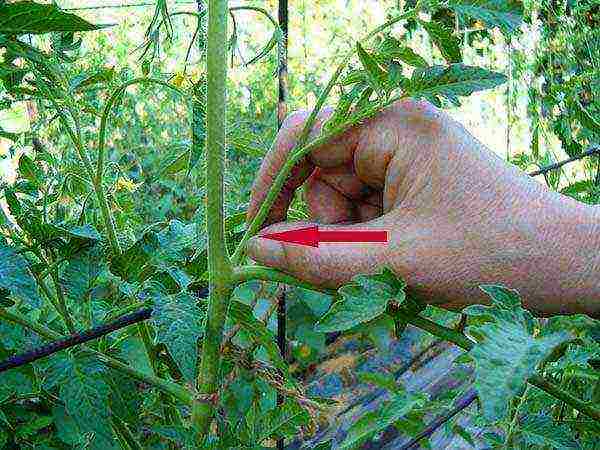 Overgrown stepson
Overgrown stepson
Important! Low-growing varieties, as a rule, do not require pinching. Is that the lowest leaves (the first two).
You also need to get rid of the lower leaves, which often actually lie on the ground. The purpose of this pruning is that if the tomato bushes are well ventilated below, then the likelihood of late blight will decrease, and better access of light to the lower fruits will be opened. It is worth starting to do this only when there are already set fruits, and they begin to pour. Moreover, the leaves are removed no higher than the first brush of tomatoes.
Pruning is convenient to carry out with a pruner or a knife.
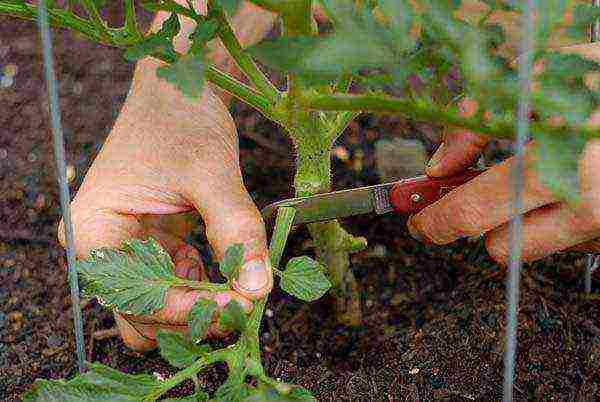
Video: pruning tomato leaves
Garter
Many varieties of tomatoes, especially tall ones, need a garter.Moreover, for tall people, as a rule, they make whole trellises for a garter.
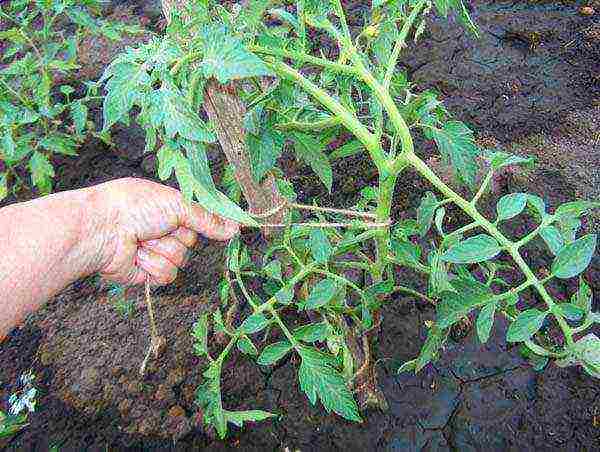
Important! You can find more information on the tomato garterin this material.
Video: garter tomatoes
Diseases and pests
Remember! Not all spots on tomato leaves lead to a decrease in yield and death of bushes.
The most dangerous are spots on the upper leaves of the bush, as well as on the leaf stalks, especially on the stems and fruits. Clear signs of dangerous diseases are spots that burn through the leaves or those that appear on the back of the leaf. Mold on the leaves can be attributed to the same group.

Less dangerous spots and practically do not affect the yield are the following:
- spots on the outside of the leaves, while the inside remains green;

- marginal burns of leaves, including the upper ones.
The main cause of most tomato diseases is high humidity. Therefore, to prevent it, you should adhere to the following recommendations:
- mulch the soil;
- watering is carried out only in the morning (if you grow tomatoes in a greenhouse) or simply do not pour if in the open field;
- ventilate the greenhouse or greenhouse (the first time after planting in the ground, the tomatoes are still under cover).
During the summer heat, it is advisable to process tomatoes every week. yeast or herbal infusion on the sheet, in other words, it will be a kind of foliar feeding for fungal diseases and phytophthora. If the rainy period comes, then the frequency of treatments should be increased up to 1 time in 4-5 days, because dampness can easily provoke the development of various fungi.
Root feeding helps well against pests. ammonia, which was mentioned in the sub-item "Top dressing".
Spraying with such drugs, like Fitosporin, Zaslon, Barrier, Ekomik, Ordan.
It is equally important not to forget in the fight against diseases trim the bottom leavesso that the bushes do not thicken.
Video: tomato diseases
Leaving in July and August
You can watch the following 2 very useful videos about caring for tomatoes in July and August (the most important growing months of this vegetable):
Tomato seedlings will have more prospects to grow, develop, and then bear fruit in the open field, if you correctly determine the timing of planting, and also take into account all the information on soil preparation, beds and caring for different varieties of tomatoes in a permanent place.
Video: growing tomatoes in the open field
Seedlings planted in a permanent place do not take root well and are sick for a long time? The reason for this is often the wrong planting of plants in the ground.
How to avoid mistakes when transplanting seedlings to a permanent place? To do this, you need to know several important rules.
General rules for planting seedlings
Transplanting is always stressful for plants. Therefore, our task is to do everything possible so that young seedlings of tomatoes, peppers, eggplants, cabbage and cucumbers endure this process painlessly.
Planting technique for a permanent place depends on:
- containers in which seedlings were grown;
- the age and size of the plants;
- the name of the culture.
Seedlings that grew in peat pots or tablets, the easiest way to land. Plants directly in containers are lowered into pre-dug holes. Then they are sprinkled with soil, squeezed from all sides with your hands so that there are no voids left, and watered abundantly.
If the plants were grown in cardboard or paper cupsdo differently. The cups are cut lengthwise with scissors and the plants are carefully removed from them, constantly holding them by the stem and trying not to disturb the earthen lump. Then each seedling is lowered into the hole, sprinkled with soil, compacted and watered well.
If the weather is cloudy, it is recommended to plant seedlings in the morning, and if it is sunny - in the late afternoon.
Plants from plastic containers They are removed as follows: with one hand, the glass is held by the middle, and with the other, by its edge, and this is done in such a way that the stem of the plant is located between the middle and index fingers. Then the container is turned over. With the hand that is closer to its center, remove the glass, and with the other hand, gently turn the seedling over and, together with a lump of earth, lower it into the hole.
To make the process of planting in the ground painless, the seedlings are stopped to water a few days before the scheduled planting date. And 1-1.5 hours before disembarkation, it is spilled with water so that the earthen lump becomes not just wet, but wet. Then it will not decay during transplantation, and the plants will hardly suffer.
Get seedlings from cassettes more difficult. This will require a small spatula, spatula, or something similar. The blade of the spatula (spatula) is carefully inserted into the gap between the wall of the container and the earthen lump, trying to raise it a little. The same is done on the other sides. After everything is ready, the plant is taken by the stem and carefully removed from the container. The further disembarkation process is the same as in the methods described above.
From common box seedlings are removed using a planting scoop. Before digging up the plants, they cut the soil into squares, in the center of which the seedlings are located. Then the scoop is buried in the soil next to the seedling, tilted it, digging in and removing the plant with a clod of earth. The dug out seedlings are in several pieces in a box, shallow bucket, basin or other similar container. Then they are planted in a greenhouse, greenhouse or garden bed.
Seedlings grown in a box will take root better if they are transferred to the planting site one at a time and directly in the planting scoop. Plants are placed in the hole together with a scoop. Then the roots of the seedlings are sprinkled with earth on three sides, and then the scoop is carefully removed, the earth is poured, compacted with your hands (especially around the stem) and watered abundantly with water.
| Culture | Terms of disembarkation in the greenhouse (in the middle lane) | Dates of landing in open ground (in the middle lane) | Planting pattern (distance between plants × distance between rows), cm |
| Tomato | Second half of May | Early to mid-June | 35-45×55-75 |
| Pepper | The end of May | Early to mid-June | 30-40×60-70 |
| Eggplant | The end of May | Early to mid-June | 30-40×50-60 |
| Cucumber | Second half of May | The beginning of June | 15-20×60-90 |
| Cabbage | – | Early May (early), early June (medium), mid-May (late) | 40-50×50-70 |
Soil preparation
A garden bed for planting seedlings of any crops is best prepared in the fall. To do this, immediately after harvesting it dig up on the bayonet of the shovel. Clods are not broken - this will allow the soil to freeze better in winter, due to which a significant part of the larvae of pests and pathogens will die.
Spring soil disinfect hot (70-80 ° C) solution of copper sulfate (1 tablespoon per 10 liters of water), spending 1-1.5 liters of product per 1 sq. m. After on the surface of the soil evenly scatter organic fertilizers (3-4 kg of manure, peat or humus per square meter), superphosphate (1 tablespoon per 1 square meter), potassium sulfate (1 tablespoon per 1 square meter) and wood ash (1 tbsp. per 1 sq. m.). Then the soil dig up and level rake.
As a rule, it takes about a month from the moment of spring tillage to planting seedlings. So that all this time the beds are not empty and not overgrown with weeds, they can be sown with early ripening plants: lettuce, spinach, radishes, watercress, dill, salad mustard, etc. These crops are harvested no later than 10 days before planting seedlings.
The greenhouse and the greenhouse also need to be disinfected (if this was not done in the fall) with a solution of copper sulfate and karbofos (2 tablespoons of each drug are diluted in 10 liters of water). To treat a greenhouse with an area of 10 square meters, you will need 10 liters of disinfectant.
How to plant tomatoes?
If the seedlings have standard sizes (height 25-35 cm and 8-10 true leaves), they are planted in the usual way. Dig a hole slightly larger than the earthen lump of the plant.A seedling is vertically installed in it and covered with fertile soil, peat or compost until the cotyledons or the first pair of true leaves (if the cotyledons were removed during the cultivation of seedlings).
Overgrown tomato seedlings are planted using one of the methods described below.
The first way. They dig a hole 8-10 cm deep and 20-30 cm long. The seedling is placed at an angle of 45 degrees so that its roots are directed to the south and the trunk to the north. At landing make sure that the trunk of the seedling does not touch the soil, and the lower leaves are located at a height of 15-20 cm from it. To achieve this, the lowest leaves are removed. It is only advisable to do this in advance, so that the wounds have time to dry out, and the infection does not get into them.
Thanks to this method of planting, overgrown tomato seedlings will have additional roots. This will increase the area of plant nutrition and increase the yield by 1.5-2 times compared to the traditional planting method.
Second way consists in the fact that first they dig a large hole 15-20 cm deep, and in it they dig another, but already smaller and 8-12 cm deep (to the height of the container in which the seedlings were grown). You should have a kind of hole in the hole with a total depth of 25-32 cm.
A seedling with a clod of earth is planted vertically in a smaller hole. Then it is covered with soil until the cotyledons or the first true leaves. After 2 weeks, when the tomato seedlings take root and get a little stronger, a large hole is covered with soil almost to the brim (the lower leaves, which may be underground, are previously removed).
This method of planting tomato seedlings is more laborious. But on the other hand, plants subsequently form more flower brushes (especially in tall tomatoes) than with traditional planting in shallow holes.
Immediately after planting, pegs with a height of 50 cm for low-growing varieties and 80 cm for medium-sized ones are installed next to the plants. Tall varieties of tomatoes are tied to longer stakes or to wires stretched under the roof of the greenhouse.
How to plant peppers and eggplants?
Pepper and eggplant are quite thermophilic crops that do not tolerate a drop in temperature. Therefore, they are planted in open ground or a greenhouse only after the ground at a depth of 10 cm warms up to 15 ° C and above.
Planting holes are dug slightly larger than the size of the containers in which the seedlings were grown. If the soil on the site is not very fertile, a handful of humus or compost is added to each hole, 1/4 tsp. superphosphate and 1 tbsp. ash. Then it is spilled with warm water.
Pepper and eggplant seedlings are planted strictly vertically to the same depth at which they grew in containers. Pegs with a height of at least 60 cm are placed near each plant. The soil around the seedlings is compacted and mulched with humus or peat.
Seedlings of peppers and eggplants will undergo transplanting much easier if the wells are spilled with hot water before planting.
How to plant cabbage?
The technology of planting cabbage seedlings is different from planting other seedlings. In order for the plants to take root in the garden, it is important to strictly adhere to the instructions:
- take a bush of cabbage seedlings in one hand;
- make a hole with the other hand, for which immerse it in the previously dug soil, pick up the earth in your palm and do not pour it out;
- place the cabbage seedling in the hole;
- scatter the earth that you held in your palm around the young plant and press it lightly, but do this very carefully so as not to break off the delicate roots.
Seedlings of cabbage are buried to true leaves, making sure not to fill up the growing point, otherwise the plants may die. When a whole bed is planted, a narrow strip of ammonium nitrate (25 g per running meter of the bed) or urea (20 g per running meter) is poured between the rows in the center. Such feeding will help young cabbage plants to start growing faster after transplanting.Then the bed is well watered, and when the water is absorbed, mulch with dry soil.
If the weather is dry and hot, it is recommended to cover cabbage seedlings with paper caps for the first few days. The same must be done if the temperature outside is abruptly colder.
How to plant cucumbers?
5-6 days before planting seedlings in the ground, the soil on the bed is dug to a depth of 15-20 cm and spilled with a hot solution of bird droppings with mullein (0.5 l of liquid mullein, 1 tbsp of bird droppings and 1 hour are diluted in 10 liters of hot water) .l. copper sulfate). Immediately after that, the bed is covered with plastic wrap to keep warm and high humidity, and left in this form until the cucumber seedlings are planted.
So that the cucumbers are better illuminated by the sun and do not suffer from fungal diseases, it is recommended to plant them in a checkerboard pattern.
The holes are dug the same size as the containers in which the seedlings were grown. Pour 2 tsp into each of them. any complex fertilizer mixed with the soil. Then the holes are watered with warm water and the cucumber seedlings are planted.
The plants are carefully removed from the containers (and if they were grown in peat cups, they are planted directly in them), placed vertically in the holes and covered with soil, slightly compacting it near the roots. Seedlings of cucumbers are planted at the same depth at which they grew before.
After 5-7 days, white tubercles will appear on the stems of the planted plants at the very surface of the soil. They should be covered with soil to stimulate the formation of additional roots. After a few days, white tubercles will again appear on the stems above the soil, they need to be sprinkled again. After two such procedures, the cucumber seedlings will be buried in the soil almost to the cotyledon leaves. At this, the addition of earth should be stopped.
If, when planting, the seedlings of cucumbers are immediately buried to the cotyledonous leaves, its roots will be deep in the ground and begin to die off due to lack of oxygen. Such plants will not begin to develop until a new root system has grown in the upper soil layer.
When planting overgrown cucumber seedlings, the stem up to the cotyledonous leaves can be sprinkled with peat, sawdust or a mixture of peat and sawdust (1: 1). But in no case do not sprinkle it with earth - this will lead to the development of root rot. Remember, the cotyledon leaves must remain above the soil level.
Treat the planting of seedlings with all responsibility and carefully observe all the necessary conditions. And so that you do not miss the first, most important feeding of the seedlings planted in a permanent place, we have prepared a convenient table with the terms and names of feeding for each crop. Download and use!
DOWNLOAD
Calendar of the first feeding of seedlings after planting
Tomato planting timing Planting seeds for seedlings and planting tomato seedlings in open ground!
Buyanov Oleg
Ryabikova boulevard, 50 Irkutsk Russia 664043
+7 (902) 546-81-72 

Date: June 29th, 2016 ||
Heading: Country life and vegetable garden
|| views: 7506
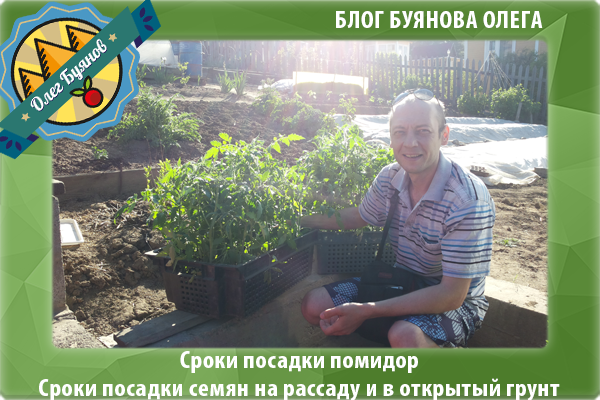
Hi guys. My new article is about tomatoes. From it you will learn about when to plant tomato seeds for seedlings. And about when to plant the resulting seedlings in open ground.
Tomato, like many members of the Solanaceae family, for example, blue, pepper, is very thermophilic. Therefore, the main factors that determine the timing of sowing the material and transplanting the finished seedlings into the soil are climatic and weather conditions at the place of cultivation.
When the ground warms up to a suitable temperature and the threat of recurrent frosts has passed, you can safely start planting plants.
I will talk about two important questions. When to plant tomato seeds for good and viable seedlings. And when to plant it in open ground. Let's start with the first question.
When to plant tomato seedlings?
Why is it best to plant tomatoes with ready-made seedlings, I told in the article, planting tomatoes with seedlings.The timing of sowing the material for seedlings is influenced by: the climatic zone, the duration of daylight hours, the characteristics and varieties of the culture.
The best option is to use regionalized seed material that is adapted to grow in your area.
Tomato seedlings prepared for planting in the beds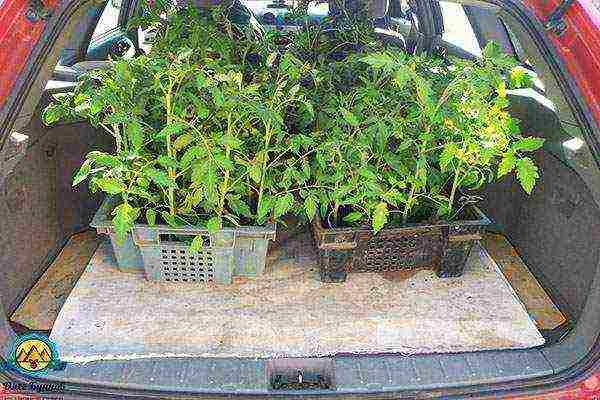
In the southern regions of Russia, hybrids and early varieties are sown for seedlings from February 25 to March 5. Plants can be transplanted into the ground when they reach a height of 15-30 cm and have at least 8 leaves. Above the landings, you need to install metal arcs so that with short-term temperature jumps, you can quickly pull on the protective film.
Sowing of seeds of medium varieties and hybrids is carried out in the first or second decades of March. Seedlings are planted in the soil when they reach 60-65 days of age. Late varieties are sown at the same time as the middle ones, or from March 20 to mid-April. By the time of transplanting, the seedlings should be 70-80 days old.
In regions with a temperate continental climate, the timing of planting a crop also depends on the type of vegetable, temperature and light conditions. If you sow the material for seedlings ahead of time, then the plants will be elongated and weakened, which will negatively affect their further growth.
Here it is, what a tomato seedling!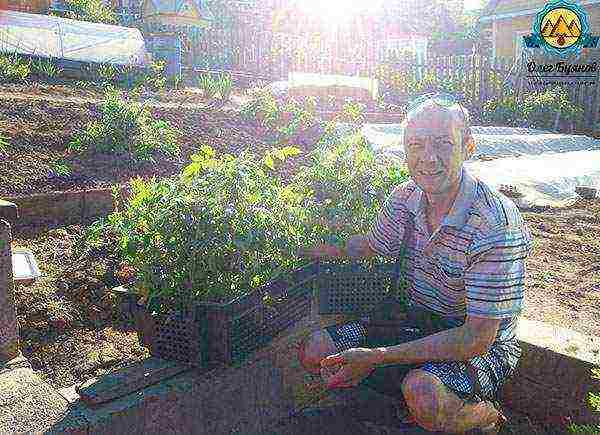
In the conditions of central Russia, as well as capturing Siberia and the Urals, it is impractical to cultivate late varieties in the open field, due to the short warm period. Therefore, it is best to grow tomato seedlings in the spring and plant them in early summer.
Sowing of early hybrids and varieties of tomatoes for seedlings is carried out during March 15-20, and early ripening F1 tomatoes - April 1-5. Medium varieties and hybrids are sown from March 20 to April 10. You can plant seedlings of culture in open earthen areas or under a film shelter for 60-65 days.
Dates for planting a tomato in open ground.
The time of planting seedlings in open ground in each region is determined individually. The main selection criteria are the temperature of the earth and air.
By the time of transplanting plants from individual containers, the earth should warm up to 15 ° C. The average daily air temperature should be 20 ° C. These are the optimal indicators for the implementation of the event, which affect the volume and quality of the further harvest.
Low temperatures are detrimental to tomatoes, therefore, if it is below 12 ° C, the ripening process of seedlings will stop altogether. You can measure the temperature of the soil with a household thermometer.
Preparing to land in the ground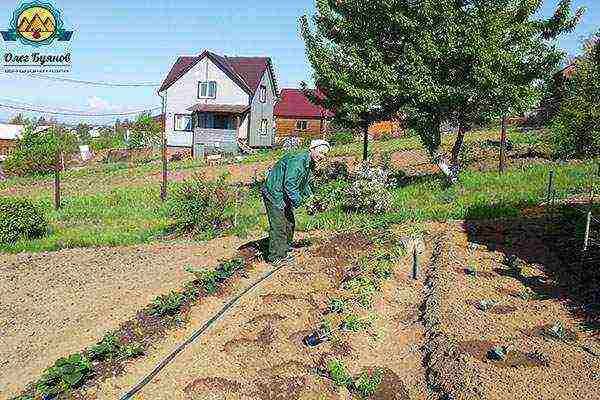
Tomato seedlings should not be planted in cold ground: in such conditions, the growth and development of seedlings slows down, and the likelihood of being affected by diseases inherent in the culture increases. Before planting plants in the ground, you need to make sure that there will be no spring frosts in the future.
In the southern regions, a favorable time for planting tomatoes in open beds for early varieties is the third decade of April, for mid-late ones - from the first to 20 days of May. After transplanting plants, you need to monitor the temperature indicators in order to cover them with a film when it gets cold.
In the middle lane and northern regions, planting of tomato seedlings in the ground is carried out in late spring - early summer, when there will be a minimum threat of return frosts. We planted tomato seedlings in early June, when even at night the air temperature rarely drops below 9 degrees. And during the day it keeps at least 20 degrees.
Planted tomatoes
But in order to avoid various temperature surprises, it is possible to plant tomatoes in the greenhouse. Many people do this too. I talked about our family planting method in the article, planting tomatoes in open ground. Do not forget that it is necessary to plant tomato seedlings on a cloudy day or in the afternoon, when solar activity decreases.
Now you know the timing of planting a tomato in open ground. I hope this article will be helpful to you and you will plant the tomatoes in the correct time frame. And of course you will get a huge harvest of tomatoes.
![]()
Tomorrow I will tell you about the important news of my blog that happened recently. And then there will be a new note from my personal life. Do not miss. It will be interesting.
Rating: 3.5 out of 5 (2 votes)
If you ask if it is possible grow tomatoes in the Middle Lane without greenhouses and greenhouses, many will answer: it is possible, but difficult. In fact, everything is extremely simple. Here is a detailed, proven instruction for you over the years.
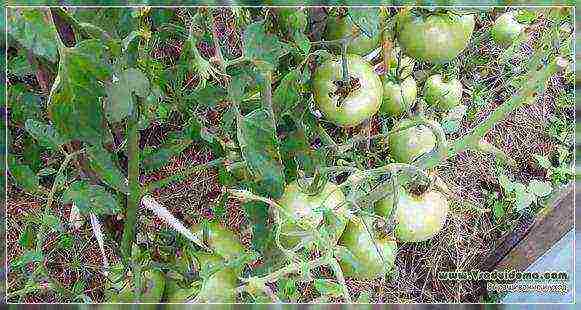
I have been working on the land for more than 30 years, growing different crops that yield crops in our region.
I don't have a greenhouse, everything grows in the open field, but I never go without a crop. I prefer tomatoes.
Basically I grow medium-sized (80-90 cm) and low ultra-early. There are no problems with seeds, I use hybrids more often. They are more productive and less susceptible to disease.
With love I look at the pictures of fruitful bushes of tall tomatoes!
I advise everyone to try it. And if you also do not have a greenhouse, do not despair - I offer you my own growing method.
See also: Recipes from tomatoes grown on your site
Sowing seeds for seedlings
I start sowing seeds in the first decade of March. I etch them in potassium permanganate for 30 minutes, then drain the solution.
I pour a little clean water into the bath and put there "little bags" - seeds etched in potassium permanganate, wrapped in x / 6 cloth. I put the bath in a bag and place it near the battery for a day or a little more. At this time, I prepare a container for sowing seeds, filling it with earth from a bag bought in a store, only adding a little clean sand to the ground.
Then I take a bath with earth, make a groove, pour it with warm water with potassium permanganate in a thin stream and spread the seeds.
Then I fall asleep with the same earth, lightly slap it - and so one after another I sow the grooves.
I put everything on a bench near the battery, cover it with foil and wait for the shoots. After 5-6 days, the first loops begin to appear. Then I put the trays in the light, and the usual care begins: watering, loosening, lighting. This is how seedlings grow up to 3-4 true leaves, after which I start picking - this is the most crucial period when growing seedlings.
I dive right into the boxes, of which there are a lot on the market. The land consists of 50% of purchased (from a package) and 50% of sod, forest, but not from the garden. I add a glass of ash and clean sand to a bucket of this mixture, fill the boxes and dive, and in two rows. Having finished with the drawer, I take it out to the balcony, there I have two racks of 5 drawers each.
It is very convenient to carry out maintenance, which consists in watering, loosening, as well as in the daily turning of the boxes - they are not heavy, very comfortable. The seedlings are slender, and super-early varieties are already beginning to bloom.
Transplanting tomato seedlings into open ground
In early May, I transfer the seedlings to the site.
There I feed her with what she has - bird droppings, mullein, mineral fertilizers, and on top of the boxes above the sides I pour humus. And my seedlings are standing, they are gaining strength, and at this time I am preparing a garden bed, holes and an earthen mixture, which consists of humus, ash and sand. I start planting seedlings after May 15, and also in two rows. Between two bushes in a row I put a peg for a garter. When landing in water, I add potassium permanganate.
After planting the seedlings, I cover the entire garden bed with acrylic No. 42. It holds well on pegs, I sprinkle it with earth in the corners, it is easy to open when leaving. At the beginning of June, I completely remove the shelter. Tomatoes grow well, bloom, and super early ones already have an ovary.
See also: Growing a tomato - how to avoid mistakes for beginners
Tomato care in the Middle Lane
The usual care is watering with herbal tincture, loosening, mulching with humus or grass, spraying with garlic infusion.
During the flowering period, I spray it with a fruit formation stimulant.
In the first decade of August, I cut off the tops of all tomatoes, 2-3 leaves from the bottom of each bush. And again I cover it with acrylic, I press the sides more tightly.Mid-early varieties begin to ripen in the third decade of July, and the whole August is ripening amicably, and ends in September. Sometimes, even in October, you can pick a ripe red tomato - depending on what the weather is, but there are no green tomatoes left on the bushes at all.
So, dear summer residents, I have been using this method for many years, I am very pleased with it. And always with tomatoes. Try it, I wish you success!
As a continuation of the topic, another letter about tomatoes without a greenhouse. But, in addition to leaving, the choice of the variety is also of great importance. Is it true that the more of them in the garden, the better?
We do not have a greenhouse, and we have to grow tomatoes under temporary shelter. Of course, I grow the seedlings myself, I really like the varieties Budenovka, Gina, Cardinal, Ox ears, Ox heart, Bullfinch, Wind rose, etc.
And I always plant two cherry bushes. And this year I planted a tomato tree, the reader sent me the seeds, for free, thank her very much. The tomatoes are medium-sized, there are many of them, and they are very, very tasty, and slightly blackish in color. I collected the seeds and will plant them next year.
I sow seeds for seedlings in late February - early March. I buy the soil, since the soil in the garden is heavy, clayey. Naturally, I disinfect the seeds, sow them by varieties in separate bowls. After 3-4 days, shoots appear, I put them on the windowsill, I often do not water them so that the black leg does not start. In the phase of two or three true leaves, I dive into separate cups (200 g) of sour cream or cut half-liter bottles. After 10 days I give top dressing with urea or diluted bird droppings. And I try to highlight it, and when it gets warmer on the balcony, I take out the seedlings for hardening.
At the beginning or in the middle of May, I plant tomatoes in the beds. I put a pinch of superphosphate, ash, tea leaves, banana peels, onion peels and egg shells in the holes. I mix it all, water with potassium permanganate and plant tomatoes. Bushes begin to grow before our eyes.
I do not water often, but abundantly and mulch. I think that it is necessary to mulch, then the earth becomes fluffy.
When the tomatoes begin to bloom, I spray it with a fruit-forming stimulant or spread 1 tsp. boric acid in a bucket of water with the addition of 10 drops of iodine, In the season 3-4 times I give top dressing: bird droppings + nettle infusion. I save from late blight with milk whey (1 liter per bucket of water) - I thoroughly moisten all the leaves.
They often write that you cannot plant tomatoes next to potatoes. And with me they always sit side by side, and I do not complain about the harvest. I will definitely stepchild tomatoes, I cut off the lower leaves, and in August I cut off the tops.
Since there are early frosts in Siberia in the fall, tomatoes have to be picked while still green, but they ripen at home. We have enough to eat, and prepare for the winter, and make sauce, and treat friends.
Who are tomatoes friends with?
As a continuation of the topic, another letter about tomatoes without a greenhouse. But, in addition to leaving, the choice of the variety is also of great importance. Is it true that the more of them in the garden, the better?
We do not have a greenhouse, and we have to grow tomatoes under temporary shelter. Of course, I grow the seedlings myself, I really like the varieties Budenovka, Gina, Cardinal, Ox ears, Ox heart, Bullfinch, Wind rose, etc.
And I always plant two cherry bushes. And this year I planted a tomato tree, the reader sent me the seeds, for free, thank her very much. The tomatoes are medium-sized, there are many of them, and they are very, very tasty, and slightly blackish in color. I collected the seeds and will plant them next year.
I sow seeds for seedlings in late February - early March. I buy the soil, since the soil in the garden is heavy, clayey. Naturally, I disinfect the seeds, sow them by varieties in separate bowls. After 3-4 days, shoots appear, I put them on the windowsill, I often do not water them so that the black leg does not start. In the phase of two or three true leaves, I dive into separate cups (200 g) of sour cream or cut half-liter bottles. After 10 days I give top dressing with urea or diluted bird droppings.And I try to highlight it, and when it gets warmer on the balcony, I take out the seedlings for hardening.
At the beginning or in the middle of May, I plant tomatoes in the beds. I put a pinch of superphosphate, ash, tea leaves, banana peels, onion peels and egg shells in the holes. I mix it all, water with potassium permanganate and plant tomatoes. Bushes begin to grow before our eyes.
I do not water often, but abundantly and mulch. I think that it is imperative to mulch, then the earth becomes fluffy.
When the tomatoes begin to bloom, I spray it with a fruit-forming stimulant or spread 1 tsp. boric acid in a bucket of water with the addition of 10 drops of iodine, In the season 3-4 times I give top dressing: bird droppings + nettle infusion. I save from late blight with milk whey (1 liter per bucket of water) - I thoroughly moisten all the leaves.
They often write that you cannot plant tomatoes next to potatoes. And with me they always sit side by side, and I do not complain about the harvest. I will definitely stepchild tomatoes, I cut off the lower leaves, and in August I cut off the tops.
Since we have early frosts in Siberia in the fall, tomatoes have to be picked while still green, but they ripen at home. We have enough to eat, and prepare for the winter, and make the sauce, and treat friends.
Interesting video - growing tomatoes using natural farming technology
Growing tomatoes (workshop on natural farming)
Below are other entries on the topic "Cottage and garden - do it yourself"
Early tomatoes without a greenhouse and other "tomato" tips: Growing tomatoes - summer resident's advice ... Do-it-yourself garter tomatoes are my way: How best and faster to tie up ... Tomatoes before October: Autumn tomatoes At the end of summer, many ... Method of planting tomatoes - 5 bushes per hole : my reviews: Experiment - we plant 5 ... Harvesting your own tomato seeds - tips: Your seeds from your tomatoes To each ... Preparing tomato seeds and the best planting dates: practical advice: When to sow seeds and how ... Tomatoes in a seedless way - my way of growing: How grow tomatoes in a seedless way ...
Subscribe to updates in our groups.
Let's be friends!

